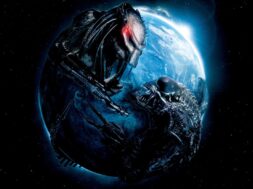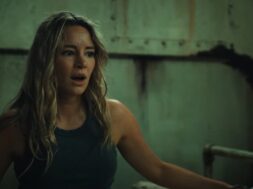It’s only natural to feel trepidation setting in for no specific reason as each new Sunday draws to a close. Statistics suggest that as many as eight out of every ten Americans experience some form of workplace stress; a common anxiety that comes in every conceivable variety.
Whether it be tight deadlines, overly exigent bosses, co-workers who go above and beyond the call of duty to win the boss’ favor – much to our chagrin – or just plain old monotony, we’ve all experienced some kind of conflict at the workplace. Case in point, as most of our waking moments are spent at work, nine-to-five stress ends up doing a number on our mental health and often drives people completely over the brink.
It’s no coincidence then that many a horror movie has explored the deadly, destructive consequences of a toxic working environment. So prepare yourself as corpses are about to stack up next to the photocopying machine as we serve up some of the most effective Monday motivation fuel known to man: a selection of workplace horror movies guaranteed to make even the most dead-end jobs feel like absolute godsends.
Next of Kin (1982)

First up is a film that could have earned a place alongside the genre-defining touchstones of the ’80s, if only it had gotten the chance. Despite capitalizing on the popular Ozploitation wave of the era, Tony Williams’ chillingly unique spin on haunted house tales surpassed Australian horror topes by taking its cues from the European genre film industry.
An all-time fave of Quentin Tarantino and fittingly compared by many a critic to Kubrick’s The Shining, the film sees Linda Stevens (Jackie Kerin) take over an ominous retirement home she’s just inherited from her late mother; a setting that unsettles her as soon as she sets foot in the place – and not just because of the intimidating group of seniors who call this place their home. Linda’s logical unease in her new surroundings are further enhanced by the fact she finds her late mother’s diary full of chillingly prophetic entries. Aided by her apathetic boyfriend Barney (a young John Jarratt), it’s up to Linda to uncover what’s really going on – or join her departed mother.
Replicating the look and feel of Italian giallo masters, Williams’ patient, slow-burn focus on atmosphere and aesthetics flexes the film’s chill factor to the full, pulling us headfirst into Linda’s perturbed headspace. More than just a simple curiosity, Next of Kin is a fascinating anomaly from one of Australian cinema’s most relevant cinematic decades.
Death Spa (1989)

Horror movies don’t get any more ’80s than Michael Fischa’s quirky and outrageous Death Spa. It’s got it all: spandex, puffy sleeves, eye-straining fabric colors, humongoid hairdos, the health-club craze, technophobia, an unmistakable Bava aesthetic and lashings upon lashings of ludicrous set splatter pieces.
Recent widower Michael Evans owns a health club controlled by a state-of-the-art computer system. If that doesn’t sound like the perfect recipe for a death trap then I don’t know what does. Of course, the computer system suddenly starts playing up leading to a number of the club’s employees and patrons having hilariously gory “accidents” before Michael starts to suspect that his late, jealous wife may somehow be involved.
Any kind of reason, laws of physics and general anatomy rules are thrown out of the window as ill-fated gym-rats are picked off by the likes of possessed blenders, rib-cracking pec decs and even a flock of psycho killer flying shower tiles. And it’s this ludicrously gory mix of supernatural horror that makes Death Spa such an unmissable bonkers affair.
Intruder (1989)

Unleashed on audiences in 1989 – a year in which the Jason, Freddy, and Michael tent-pole franchises all released less-than-stellar entries – Scott Spiegel’s wildly inventive whodunnit slasher opus capitalized on the sense of sameness that had crept into the slasher sub-genre.
Combining serious, tongue-firmly-out-of-cheek horror with genuine laughs – that never devolve into self-parody, Intruder shadows a group of people working the night shift in the Walnut Lake Market grocery store. One by one, an unknown killer knocks off each employee in increasingly outrageous fashion, thanks to some audacious gore effects provided by the then fledgling special effects company KNB EFX Group (AKA Robert Kurtzman, Greg Nicotero and Howard Berger).
Whilst there’s no denying that budget constraints left Intruder packing a lot less flair and charisma than the likes of Halloween or Friday the 13th, it more than made up for those shortcomings by outdoing pretty much every other slasher movie that predated it in the ’80s in terms of brutality and intensity. As inventively gory genre comedies go, it’s among the best the ’80s had to offer.
I, Madman (1989)

Tibor Takacs’ (The Gate) I, Madman might not be the best, but it’s by far the most unique workplace film on this list, elevating standard pulpy noir fare by reversing roles and spicing things up with heavy elements of rubber reality horror a la Wes Craven.
Released to little fanfare in 1989, Jenny Wright stars as Virginia, an erudite bookstore employee who’s a big fan of obscure, genre pulp novels. Her latest go-to author is Malcolm Brand, but he’s only released two novels – “Much of Madness, More of Sin” and “I, Madman” and the latter is impossible to find, even though she works in a bookstore. As good (or bad) luck would have it, the much sought after title suddenly turns up on her front doorstep, opening a rift between the literary world and the real one with an insane surgeon escaping from the book’s pages, intent on murdering everyone close to Virginia so he can surgically add pieces of their faces to his own to gain her affection.
I, Madman was – and still is – a revelation for horror fans as the bookstore setting and unique premise explores why we love a good old gruesome story whilst scrutinizing the sort of mindset it takes to come up with this sort of creepy media in the first place. Ultimately, I, Madman marked a surprisingly mature step in the evolution of horror at a time when stalwart sameness was creeping its way into the genre.
Nightwatch (1997)

This next film takes us to one of the most inherently creepy places anyone could aspire to get a job at: the morgue.
Ole Bornedal, directing a remake of his own 1994 Danish hit, Nattevagten, finds Law student Martin Bells (Ewan McGregor) hired as the overnight security guard at a morgue. And whilst his girfliend is anything but keen on the idea, his best friend James (Josh Brolin) couldn’t be more delighted, seeing it as an opportunity for all manner of morbid high jinks. But Martin’s new job is anything but a laughing matter as a series of brutal killings lead Inspector Thomas Cray (Nick Nolte) and his deputy Bill Davis (John C. Reilly) to the morgue – with all evidence suggesting Martin is the culprit.
Far from a simple piece of morbid genre fare, Bornedal serves up some inspired gallows humor and wisely devotes screen time to real-world fears such as post-grad life and marriage issues which injects some additional believability into the characters. Bar a few cracks here and there, Nightwatch packs plenty of curiously morbid thrills, jump in your seat frights and those always welcome clue-spotting joys that make films of this ilk so ripe for repeat viewings.
The Corpse of Anna Fritz (2015)

Jumping from one morgue setting to another, Hèctor Hernández Vicens takes things drastically darker, telling the tale of a group of youths who can’t keep it in their pants when they happen across the corpse of the beautiful actress, Anna Fritz, laid bare in the mortuary where one of them works. If that doesn’t already have you thinking cremation might be the better of two options, the film was also loosely inspired by the real-life case of a mortuary worker who violated a cadaver which awoke from a catatonic state mid-coitus.
Sinister preamble aside, and the fact that necrophilia is one of the world’s eternal anathemas, Hernández Vicens tackles the subject matter with surprising sensitivity. Even though you know what you’re watching is as repulsive as it comes, it’s delivered in such a way that you won’t be able to look the other way. If you think you are up to the ordeal, the early “necrophilia” scenes are more than worth riding out because the aftermath is to die for.
Session 9 (2001)

Brad Anderson became a horror-fan favorite with this one. A masterclass in the power of shuddersome suggestion, the film’s greatest strength is the atmosphere created by its workplace setting: an ominous abandoned mental asylum where the film’s protagonists, an asbestos cleanup crew, are tasked with removing insidious asbestos-panel drop ceilings from certain areas to make the building usable again.
Deadline pressures, the stress associated with the task at hand and an ever-present aura of human suffering, combined with the psychological makeup of the crew, make them particularly vulnerable to the unremittingly grim working environment; meaning it’s only a matter of time before all hell eventually breaks loose.
Much like with Kubrick’s The Shining, the film setting’s air of looming dread is so effective that it will linger with you long after you’ve seen it.
Infection (Kansen) (2004)

Quick word of warning. Those with a white coat syndrome may want to hop straight onto the next film in the list…
Hospitals are the last place anyone enjoys having to pay a friend or relative a visit, let alone being admitted to one themselves and yet Masayuki Ochiai succeeds in heightening this common fear of hospitals to even more dire proportions.
Welcome to the dingiest, shabbiest and most disconcerting hospital on the planet run by equally shady nursing staff hell-bent on covering up their medical negligences. To make matters worse, a new patient is admitted, host to a lethal parasite that turns its victims into raving loonies before eroding their internal organs into a gangrenous pulp.
And then, to top it all off, Ochiai injects a scathing health care commentary guaranteed to have you eating an apple a day to keep the doctor the hell away.
[REC] (2008)

This next film kills two jobs with one stone, quite literally. In the early stages of Jaume Balagueró and Paco Plaza’s [REC], we’re softened up with an ingenious concept as we follow a reality TV crew shadowing a team of firefighters over the course of one night. All seems innocuously quiet until a call comes in requiring their services as an ageing woman is trapped in her apartment. Unluckily for them, the woman in question just happens to be a blood-lusting zombie-of-sorts, and the whole film takes a shuddersome about turn as the the building is swiftly put under a quarantine lockdown with no manner of escape.
The apartment block setting and its everyday residents and visitors – who gradually fall victim to the infected and/or the infection – make for the perfect haunted house ride with rage and delirium escalating within the claustrophobic confines of the building. Then, just when you think there’s nowhere else for the film to go, it throws in a last-minute supernatural swerve ball which cranks the shock levels through the roof, whilst providing the perfect set up for an equally strong sequel.
The Innkeepers (2011)

Ti West’s fifth film, The Innkeepers, is his best to date, at least for this writer. Shot at the real life (and reportedly haunted) Yankee Pedlar hotel – where the cast and crew stayed whilst filming West’s baby-sitter-in-peril movie, The House of the Devil – Sara Paxton and Pat Healy star as two twenty-something hotel clerks on a mission to prove that the site is indeed inhabited by ghosts.
The film pitch-perfectly portrays Paxton and Healy’s characters as two like-minded people with nothing better to talk about, cleverly turning the absolute boredness that comes with “supernatural stake outs” into something quite extraordinary. And this is by and large thanks to the cleverly constructed chemistry and awkard realism shared by the leading duo.
But the real key to The Innkeepers‘ success is West’s decision to obviate the metatextual monkeyshines that plagued the post-Scream era, dextrously poking fun at horror movie tropes whilst still succeeding at keeping things scary. A skill that allowed West to reinvent the classic haunted house wheel with very few bells and whistles.









